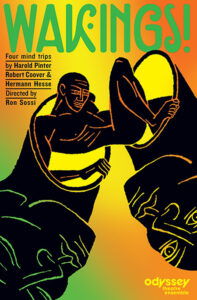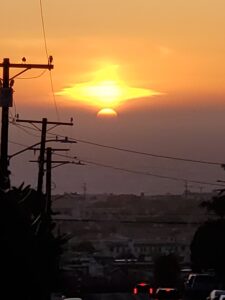‘Wakings!,’ Ron Sossi’s quartet of lesser-known Pinter, unknown Coover, and better-known Hesse attempts with varying success to explore ‘models of consciousness’ as Occidental eyes turn inward and then Eastward.
In ‘Rip Awake,’ Darrell Larson who excelled in pre-COVID Strindberg lets it fly as Rip Van Winkle left to figure out what and who is left of his former world. Robert Coover, the only non-Nobelist on the bill, has written a nice although a touch too long fourth-wall breaking rant where Van Winkle limns the difficult mechanics of his awakening to soft bones, spiral toenails, and frayed mind. It’s a meaty monologue for the ‘actor of a certain age’ and Larson rages and brawls about the stage with mountain-goat confidence.
Pinter the writer had long become Pinter, dissertation fodder by the time he wrote ‘A Kind of Alaska’ in 1982. Deborah (Diana Cignoni), now 45, awakes after succumbing to sleeping sickness at age 16 with her devoted doctor (Ron Bottitta) and long-suffering sister (Kristina Ladegaard) attending. Deborah is nostalgic, uncertain, and kind of a … jerk towards the few she has left and there is a small twist in why these two people still hang about her. There is some good writing in her coming to and coming to grips with her situation but the mixing of German, Nordic, and British accents dislocates the situation. For all the acclaim, Pinter is narrowly focussed on specific castes of British jackholes (that American audiences find endlessly fascinating) and efforts to apply him outside that milieu can run into trouble.
The bookends are less effective. ‘Victoria Station’ another 1982 Pinter effort has taxi dispatcher Bottitta trying in vain to get driver C.J. O’Toole to pick up a fare. The driver has, to be charitable, checked out, cruising around long gone London landmarks infatuated with a possibly dead passenger. These Pinters are lesser-known for a reason, the malevolent craftsman behind ‘The Caretaker,’ ‘No Man’s Land,’ and ‘Betrayal’ is barely visible with scarcely a memorable line in the pair. O’Toole returns in a non-speaking solo in the closer as Siddhartha rambling wild like Rip at first, later finding a secret of time and his enlightenment in a river. Castmates narrate earnestly from the novel to a clichéd music track.
Yet it is still worth a look. Self-admittedly a scratching of the surface, Sossi paradoxically succeeds even when the playlets individually stumble. Models of consciousness aside, there is a strong resonance to a world full of bottled rage peeking out from years of isolation, relearning how to act among others, and looking for some meaning in it all. The dispatcher’s bosses don’t care that he’s alone, overworked, and can’t get through to a disaffected employee – there’s profit to be had. Self-centered Deborah alternately denies her condition and snarks at her long-suffering caregivers. Rip is out for revenge against those, real or perceived, responsible for his prolonged slumber. He turns wild and this being America, turns gun against dog and daughter imagining them to be others all the while. The woman to my left just had to consult her phone well into the fourth act. We live this insanity each and every day with no end in sight and even worse on the horizon. Against all that, the Hesse is an earnest attempt at hope and release. Whether it succeeds or not is up to each viewer.
There are doubtless easier ways to rebuild audience after a plague. Many Manchin Democrats argue that this is the time for trivial comedy by the usual suspects. Audiences should consider rewarding The Odyssey for going against that grain and taking this calculated risk.
Wakings!
Directed by Ron Sossi for the Odyssey Theatre Ensemble
Through 5 June 2022
Friday & Saturday 8pm, Sunday 2pm, May 25 8pm
The Odyssey Theatre Ensemble
2055 S. Sepulveda Blvd.
Los Angeles, CA 90025
Box Office: 310-477-2055 ext. 2
Online ticketing through Ovationtix


